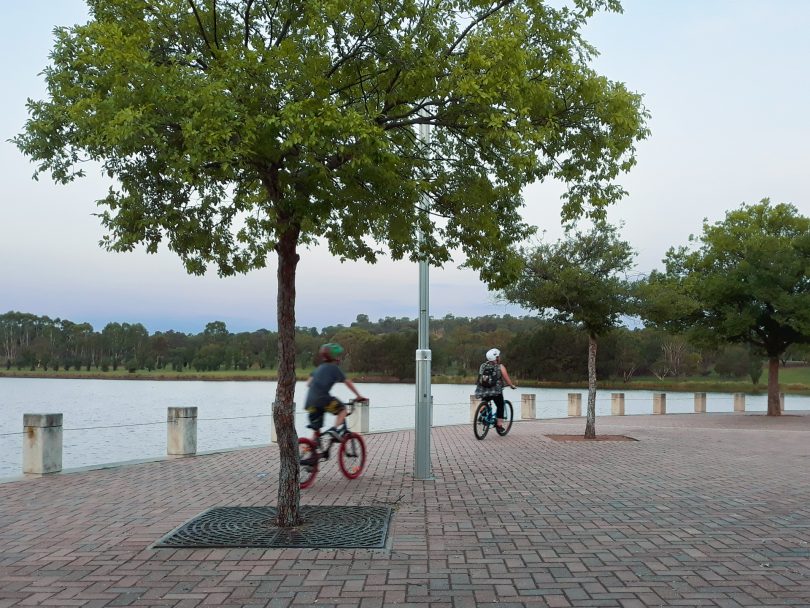
An evening ride around Lake Tuggeranong. Photo: James Coleman.
Eucalyptus trees are a defining feature of Canberra’s landscape, but there’s no doubt the native species can make a right mess of anything underneath and, in the case of the fallen leaves, go on to pollute our waterways.
Help is at hand. Supported by the ACT Government, Griffith University in Queensland is calling for members of the public to participate in an online survey to find out where your street’s gum leaves are going.
Social Marketing @ Griffith founding director Sharyn Rundle-Thiele describes it as part of a larger project that will ultimately see her team from ‘The Leaf Collective’ find a range of ways to help clean up Canberra’s act.
“I think most of us don’t realise that leaves can be harmful,” she says. “We think they’re great, and we know leaves can make good compost, but for Canberra lakes, they’re about as bad as a cigarette butt.”
The ACT is built around waterways and studded with lakes in every major region, many of them fed by concrete channels that are, in turn, fed with stormwater from the roadside drains and gutters in the suburbs. Anything you wash down the drain can end up in your nearest lake, and that isn’t always a good thing.
Leaf litter can not only clog the waterways, but it also promotes the growth of algae, unappealing to look at and unhealthy for aquatic life – even toxic to humans and dogs in the case of blue-green algae.
“In water, leaves release chemicals that create the perfect conditions for algal blooms. The science is clear – leaf litter is definitely one of the contributors to water pollution, and it’s something we can all help with to get those waterways clearer.”
The campaign focuses on finding ways to support households to deal with leaf litter in the cleanest, most efficient way.
The first stage consists of an online community survey designed to determine what Canberrans think about leaf litter.

Social Marketing @ Griffith Founding Director Sharyn Rundle-Thiele. Photo: Griffith University.
This will be followed by co-design sessions, hosting people from different backgrounds and skillsets to help design the campaign. A $50 voucher will be thrown in as a thank-you gift to those who partake.
“It’s about pulling together what’s already happening and getting some more momentum behind it,” Sharyn says.
Equipped with this information, the final part involves approaching various local service providers to find out how they can get involved.
“We’re really interested in hearing great ideas about what we can do and not do. Can we get behind something that’s already on the ground and promote it? Can a service provider help a household that can’t help themselves? Are some prepared to just get out there and help clean up the leaves themselves?”
The online survey has been live since 12 November. Initial responses suggest that one-in-three Canberrans have collected native leaf litter from the gutter or nature strip outside their residence in the last month, despite mixed views on who is ultimately responsible for tidying up leaf litter.
Up to 40 per cent of people have disposed of these leaves in their standard government-issued bin. This indicates that a lot of leaves are going straight to landfill rather than green waste.
Sharyn says the jury is still out about what people think of native leaf litter and whether or not it is lowering water quality.
The campaign in earnest will kick off in February 2022, focusing first on the Tuggeranong area.
“How this will look is all determined by what we learn from the three different parts of the research that we’re running. I’m still learning myself on this project, but there are going to be amazing alternatives out there, and we’d love to hear more about them.”
The 33-question online survey is open until 3 December and can be found on the Griffith University website. It’s estimated to take no more than 10 minutes to complete.
For more information and regular updates on the program’s progress, visit The Leaf Collective Facebook page.












